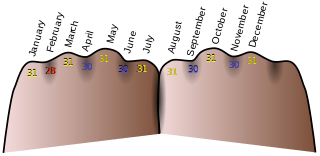
Back Eselsbrug Afrikaans استذكار Arabic Mnemonika Azerbaijani Мнемоника Bulgarian স্মৃতিবর্ধনবিদ্যা Bengali/Bangla Mnemotechnická pomůcka Czech Cofair Welsh Merkspruch German Μνημονικός κανόνας Greek Memorhelpilo Esperanto
This article has multiple issues. Please help improve it or discuss these issues on the talk page. (Learn how and when to remove these messages)
|

A mnemonic device (/nɪˈmɒnɪk/ nih-MON-ik)[1] or memory device is any learning technique that aids information retention or retrieval in the human memory, often by associating the information with something that is easier to remember.
It makes use of elaborative encoding, retrieval cues and imagery as specific tools to encode information in a way that allows for efficient storage and retrieval. It aids original information in becoming associated with something more accessible or meaningful—which in turn provides better retention of the information.
Commonly encountered mnemonics are often used for lists and in auditory form such as short poems, acronyms, initialisms or memorable phrases. They can also be used for other types of information and in visual or kinesthetic forms. Their use is based on the observation that the human mind more easily remembers spatial, personal, surprising, physical, sexual, humorous and otherwise "relatable" information rather than more abstract or impersonal forms of information.
Ancient Greeks and Romans distinguished between two types of memory: the "natural" memory and the "artificial" memory. The former is inborn and is the one that everyone uses instinctively. The latter in contrast has to be trained and developed through the learning and practice of a variety of mnemonic techniques.
Mnemonic systems are techniques or strategies consciously used to improve memory. They help use information already stored in long-term memory to make memorization an easier task.[2]
- ^ "mneme". The Chambers Dictionary (9th ed.). Chambers. 2003. ISBN 0-550-10105-5.
- ^ Carlson, Neil; et al. (March 2010). Psychology the Science of Behavior. Pearson Canada, United States of America. p. 245. ISBN 978-0-205-64524-4.